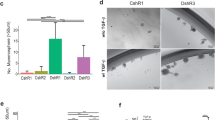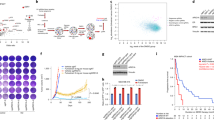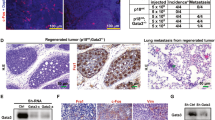Abstract
Breast cancer is a heterogeneous disease that comprises multiple subtypes. Luminal subtype tumors confer a more favorable patient prognosis, which is, in part, attributed to estrogen receptor (ER)-α positivity and antihormone responsiveness. Expression of the forkhead box transcription factor, FOXA1, similarly correlates with the luminal subtype and patient survival, but is also present in a subset of ER-negative tumors. FOXA1 is also consistently expressed in luminal breast cancer cell lines even in the absence of ER. In contrast, breast cancer cell lines representing the basal subtype do not express FOXA1. To delineate an ER-independent role for FOXA1 in maintaining the luminal phenotype, and hence a more favorable prognosis, we performed expression microarray analyses on FOXA1-positive and ER-positive (MCF7, T47D), or FOXA1-positive and ER-negative (MDA-MB-453, SKBR3) luminal cell lines in the presence or absence of transient FOXA1 silencing. This resulted in three FOXA1 transcriptomes: (1) a luminal signature (consistent across cell lines), (2) an ER-positive signature (restricted to MCF7 and T47D) and (3) an ER-negative signature (restricted to MDA-MB-453 and SKBR3). Gene set enrichment analyses revealed FOXA1 silencing causes a partial transcriptome shift from luminal to basal gene expression signatures. FOXA1 binds to a subset of both luminal and basal genes within luminal breast cancer cells, and loss of FOXA1 increases enhancer RNA transcription for a representative basal gene (CD58). These data suggest FOXA1 directly represses a subset of basal signature genes. Functionally, FOXA1 silencing increases migration and invasion of luminal cancer cells, both of which are characteristics of basal subtype cells. We conclude FOXA1 controls plasticity between basal and luminal breast cancer cells, not only by inducing luminal genes but also by repressing the basal phenotype, and thus aggressiveness. Although it has been proposed that FOXA1-targeting agents may be useful for treating luminal tumors, these data suggest that this approach may promote transitions toward more aggressive cancers.
This is a preview of subscription content, access via your institution
Access options
Subscribe to this journal
Receive 50 print issues and online access
$259.00 per year
only $5.18 per issue
Buy this article
- Purchase on Springer Link
- Instant access to full article PDF
Prices may be subject to local taxes which are calculated during checkout






Similar content being viewed by others
Accession codes
References
Perou CM, Sorlie T, Eisen MB, van de Rijn M, Jeffrey SS, Rees CA et al. Molecular portraits of human breast tumours. Nature 2000; 406: 747–752.
Sorlie T, Perou CM, Tibshirani R, Aas T, Geisler S, Johnsen H et al. Gene expression patterns of breast carcinomas distinguish tumor subclasses with clinical implications. Proc Natl Acad Sci USA 2001; 98: 10869–10874.
EBCTCG. Effects of chemotherapy and hormonal therapy for early breast cancer on recurrence and 15-year survival: an overview of the randomised trials. Lancet 2005; 365: 1687–1717.
Rakha EA, Reis-Filho JS, Ellis IO . Basal-like breast cancer: a critical review. J Clin Oncol 2008; 26: 2568–2581.
Lim E, Vaillant F, Wu D, Forrest NC, Pal B, Hart AH et al. Aberrant luminal progenitors as the candidate target population for basal tumor development in BRCA1 mutation carriers. Nat Med 2009; 15: 907–913.
Molyneux G, Geyer FC, Magnay FA, McCarthy A, Kendrick H, Natrajan R et al. BRCA1 basal-like breast cancers originate from luminal epithelial progenitors and not from basal stem cells. Cell Stem Cell 2010; 7: 403–417.
Neve RM, Chin K, Fridlyand J, Yeh J, Baehner FL, Fevr T et al. A collection of breast cancer cell lines for the study of functionally distinct cancer subtypes. Cancer Cell 2006; 10: 515–527.
Charafe-Jauffret E, Ginestier C, Monville F, Finetti P, Adelaide J, Cervera N et al. Gene expression profiling of breast cell lines identifies potential new basal markers. Oncogene 2006; 25: 2273–2284.
Wolf I, Bose S, Williamson EA, Miller CW, Karlan BY, Koeffler HP . FOXA1: Growth inhibitor and a favorable prognostic factor in human breast cancer. Int J Cancer 2006; 120: 1013–1022.
Badve S, Turbin D, Thorat MA, Morimiya A, Nielsen TO, Perou CM et al. FOXA1 expression in breast cancer--correlation with luminal subtype A and survival. Clin Cancer Res 2007; 13 (Part 1): 4415–4421.
Habashy HO, Powe DG, Rakha EA, Ball G, Paish C, Gee J et al. Forkhead-box A1 (FOXA1) expression in breast cancer and its prognostic significance. Eur J Cancer 2008; 44: 1541–1551.
Thorat MA, Marchio C, Morimiya A, Savage K, Nakshatri H, Reis-Filho JS et al. Forkhead box A1 expression in breast cancer is associated with luminal subtype and good prognosis. J Clin Pathol 2008; 61: 327–332.
Albergaria A, Paredes J, Sousa B, Milanezi F, Carneiro V, Bastos J et al. Expression of FOXA1 and GATA-3 in breast cancer: the prognostic significance in hormone receptor-negative tumours. Breast Cancer Res 2009; 11: R40.
Mehta RJ, Jain RK, Leung S, Choo J, Nielsen T, Huntsman D et al. FOXA1 is an independent prognostic marker for ER-positive breast cancer. Breast Cancer Res Treat 2012; 131: 881–890.
Bernardo GM, Keri RA . FOXA1: a transcription factor with parallel functions in development and cancer. Biosci Rep 2012; 32: 113–130.
Carroll JS, Liu XS, Brodsky AS, Li W, Meyer CA, Szary AJ et al. Chromosome-wide mapping of estrogen receptor binding reveals long-range regulation requiring the forkhead protein FoxA1. Cell 2005; 122: 33–43.
Laganiere J, Deblois G, Lefebvre C, Bataille AR, Robert F, Giguere V . From the Cover: Location analysis of estrogen receptor alpha target promoters reveals that FOXA1 defines a domain of the estrogen response. Proc Natl Acad Sci USA 2005; 102: 11651–11656.
Cirillo LA, McPherson CE, Bossard P, Stevens K, Cherian S, Shim EY et al. Binding of the winged-helix transcription factor HNF3 to a linker histone site on the nucleosome. EMBO J 1998; 17: 244–254.
Cirillo LA, Zaret KS . An early developmental transcription factor complex that is more stable on nucleosome core particles than on free DNA. Mol Cell 1999; 4: 961–969.
Cirillo LA, Lin FR, Cuesta I, Friedman D, Jarnik M, Zaret KS . Opening of compacted chromatin by early developmental transcription factors HNF3 (FoxA) and GATA-4. Mol Cell 2002; 9: 279–289.
Lupien M, Eeckhoute J, Meyer CA, Wang Q, Zhang Y, Li W et al. FoxA1 translates epigenetic signatures into enhancer-driven lineage-specific transcription. Cell 2008; 132: 958–970.
Hurtado A, Holmes KA, Ross-Innes CS, Schmidt D, Carroll JS . FOXA1 is a key determinant of estrogen receptor function and endocrine response. Nat Genet 2011; 43: 27–33.
Bernardo GM, Lozada KL, Miedler JD, Harburg G, Hewitt SC, Mosley JD et al. FOXA1 is an essential determinant of ERalpha expression and mammary ductal morphogenesis. Development 2010; 137: 2045–2054.
Mallepell S, Krust A, Chambon P, Brisken C . Paracrine signaling through the epithelial estrogen receptor alpha is required for proliferation and morphogenesis in the mammary gland. Proc Natl Acad Sci USA 2006; 103: 2196–2201.
Feng Y, Manka D, Wagner KU, Khan SA . Estrogen receptor-alpha expression in the mammary epithelium is required for ductal and alveolar morphogenesis in mice. Proc Natl Acad Sci USA 2007; 104: 14718–14723.
Mueller SO, Clark JA, Myers PH, Korach KS . Mammary gland development in adult mice requires epithelial and stromal estrogen receptor alpha. Endocrinology 2002; 143: 2357–2365.
Doane AS, Danso M, Lal P, Donaton M, Zhang L, Hudis C et al. An estrogen receptor-negative breast cancer subset characterized by a hormonally regulated transcriptional program and response to androgen. Oncogene 2006; 25: 3994–4008.
Robinson JL, Macarthur S, Ross-Innes CS, Tilley WD, Neal DE, Mills IG et al. Androgen receptor driven transcription in molecular apocrine breast cancer is mediated by FoxA1. EMBO J 2011; 30: 3019–3027.
Naderi A, Hughes-Davies L . A functionally significant cross-talk between androgen receptor and ErbB2 pathways in estrogen receptor negative breast cancer. Neoplasia 2008; 10: 542–548.
Yamaguchi N, Ito E, Azuma S, Honma R, Yanagisawa Y, Nishikawa A et al. FoxA1 as a lineage-specific oncogene in luminal type breast cancer. Biochem Biophys Res Commun 2008; 365: 711–717.
Williamson EA, Wolf I, O′Kelly J, Bose S, Tanosaki S, Koeffler HP . BRCA1 and FOXA1 proteins coregulate the expression of the cell cycle-dependent kinase inhibitor p27(Kip1). Oncogene 2006; 25: 1391–1399.
Hollier BG, Evans K, Mani SA . The epithelial-to-mesenchymal transition and cancer stem cells: a coalition against cancer therapies. J Mammary Gland Biol Neoplasia 2009; 14: 29–43.
Finlin BS, Gau CL, Murphy GA, Shao H, Kimel T, Seitz RS et al. RERG is a novel ras-related, estrogen-regulated and growth-inhibitory gene in breast cancer. J Biol Chem 2001; 276: 42259–42267.
Frasor J, Danes JM, Komm B, Chang KC, Lyttle CR, Katzenellenbogen BS . Profiling of estrogen up- and down-regulated gene expression in human breast cancer cells: insights into gene networks and pathways underlying estrogenic control of proliferation and cell phenotype. Endocrinology 2003; 144: 4562–4574.
Ni M, Chen Y, Lim E, Wimberly H, Bailey ST, Imai Y et al. Targeting androgen receptor in estrogen receptor-negative breast cancer. Cancer Cell 2011; 20: 119–131.
Schug J . Using TESS to predict transcription factor binding sites in DNA sequence. Current Protocols in Bioinformatics 2008; 21: 2.6.1–2.6.15.
Serandour AA, Avner S, Percevault F, Demay F, Bizot M, Lucchetti-Miganeh C et al. Epigenetic switch involved in activation of pioneer factor FOXA1-dependent enhancers. Genome Res 2011; 21: 555–565.
Eeckhoute J, Carroll JS, Geistlinger TR, Torres-Arzayus MI, Brown M . A cell-type-specific transcriptional network required for estrogen regulation of cyclin D1 and cell cycle progression in breast cancer. Genes Dev 2006; 20: 2513–2526.
Kim TK, Hemberg M, Gray JM, Costa AM, Bear DM, Wu J et al. Widespread transcription at neuronal activity-regulated enhancers. Nature 2010; 465: 182–187.
Wang D, Garcia-Bassets I, Benner C, Li W, Su X, Zhou Y et al. Reprogramming transcription by distinct classes of enhancers functionally defined by eRNA. Nature 2011; 474: 390–394.
Malik S, Jiang S, Garee JP, Verdin E, Lee AV, O′Malley BW et al. Histone deacetylase 7 and FoxA1 in estrogen-mediated repression of RPRM. Mol Cell Biol 2010; 30: 399–412.
Gorski JJ, James CR, Quinn JE, Stewart GE, Staunton KC, Buckley NE et al. BRCA1 transcriptionally regulates genes associated with the basal-like phenotype in breast cancer. Breast Cancer Res Treat 2010; 122: 721–731.
Sahu B, Laakso M, Ovaska K, Mirtti T, Lundin J, Rannikko A et al. Dual role of FoxA1 in androgen receptor binding to chromatin, androgen signalling and prostate cancer. EMBO J 2011; 30: 3962–3976.
Kouros-Mehr H, Slorach EM, Sternlicht MD, Werb Z . GATA-3 maintains the differentiation of the luminal cell fate in the mammary gland. Cell 2006; 127: 1041–1055.
Asselin-Labat ML, Sutherland KD, Barker H, Thomas R, Shackleton M, Forrest NC et al. Gata-3 is an essential regulator of mammary-gland morphogenesis and luminal-cell differentiation. Nat Cell Biol 2007; 9: 201–209.
Kouros-Mehr H, Bechis SK, Slorach EM, Littlepage LE, Egeblad M, Ewald AJ et al. GATA-3 links tumor differentiation and dissemination in a luminal breast cancer model. Cancer Cell 2008; 13: 141–152.
Nakanishi T, Chumsri S, Khakpour N, Brodie AH, Leyland-Jones B, Hamburger AW et al. Side-population cells in luminal-type breast cancer have tumour-initiating cell properties, and are regulated by HER2 expression and signalling. Br J Cancer 2010; 102: 815–826.
Liu YN, Lee WW, Wang CY, Chao TH, Chen Y, Chen JH . Regulatory mechanisms controlling human E-cadherin gene expression. Oncogene 2005; 24: 8277–8290.
Krum SA, Miranda-Carboni GA, Lupien M, Eeckhoute J, Carroll JS, Brown M . Unique ERalpha cistromes control cell type-specific gene regulation. Mol Endocrinol 2008; 22: 2393–2406.
Fu X, Huang C, Schiff R . More on FOX News: FOXA1 on the horizon of estrogen receptor function and endocrine response. Breast Cancer Res 2011; 13: 307.
de Graauw M, van Miltenburg MH, Schmidt MK, Pont C, Lalai R, Kartopawiro J et al. Annexin A1 regulates TGF-beta signaling and promotes metastasis formation of basal-like breast cancer cells. Proc Natl Acad Sci USA 2010; 107: 6340–6345.
Subramanian A, Tamayo P, Mootha VK, Mukherjee S, Ebert BL, Gillette MA et al. Gene set enrichment analysis: a knowledge-based approach for interpreting genome-wide expression profiles. Proc Natl Acad Sci USA 2005; 102: 15545–15550.
Smyth GK . Individual channel analysis of two-colour microarrays. Proceedings of the 55th Session of the International Statistics Institute, Paper 116; 2005; Sydney, Australia.
Acknowledgements
This work is supported by the Department of Defense (W81XWH-06-1-0712, GMB; W81XWH-09-1-0696, STS; W81XWH-08-1-0347, RAK), the National Institutes of Health (T32-HD-07104-33, GMB; UL1-RR024989, GB; R01 CA090398, RAK), the Case Western Reserve University Comprehensive Cancer Center (P30 CA043703, GB and RAK), a University Hospitals of Cleveland Pathology Research Associates Grant (FWA and RAK) and a Fox Chase Cancer Center Support Grant (P30 CA006927, AKG).
Author information
Authors and Affiliations
Corresponding author
Ethics declarations
Competing interests
The authors declare no conflict of interest.
Additional information
Supplementary Information accompanies the paper on the Oncogene website
Supplementary information
Rights and permissions
About this article
Cite this article
Bernardo, G., Bebek, G., Ginther, C. et al. FOXA1 represses the molecular phenotype of basal breast cancer cells. Oncogene 32, 554–563 (2013). https://doi.org/10.1038/onc.2012.62
Received:
Revised:
Accepted:
Published:
Issue Date:
DOI: https://doi.org/10.1038/onc.2012.62
Keywords
This article is cited by
-
Identification of aberrant luminal progenitors and mTORC1 as a potential breast cancer prevention target in BRCA2 mutation carriers
Nature Cell Biology (2024)
-
Epigenomic mapping identifies an enhancer repertoire that regulates cell identity in bladder cancer through distinct transcription factor networks
Oncogene (2023)
-
Loss of SNAI1 induces cellular plasticity in invasive triple-negative breast cancer cells
Cell Death & Disease (2022)
-
Gene expression signatures of individual ductal carcinoma in situ lesions identify processes and biomarkers associated with progression towards invasive ductal carcinoma
Nature Communications (2022)
-
Breast cancer plasticity is restricted by a LATS1-NCOR1 repressive axis
Nature Communications (2022)



